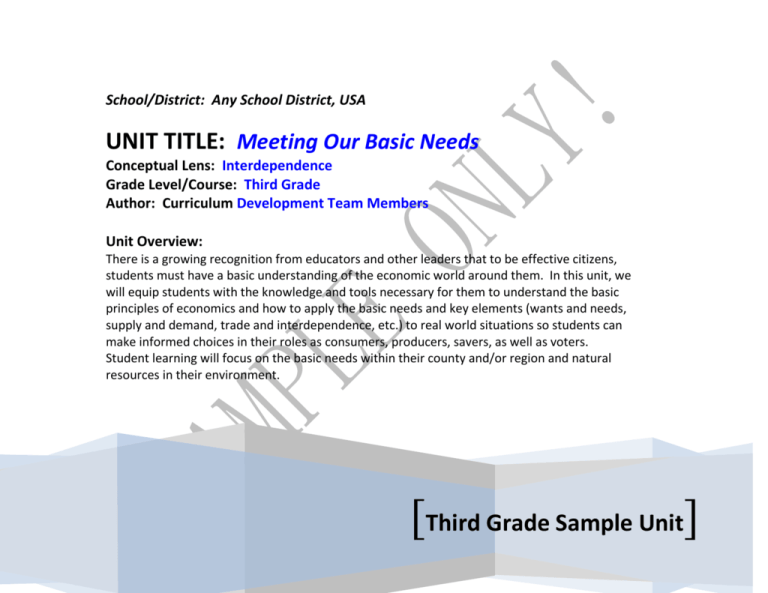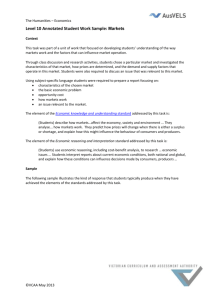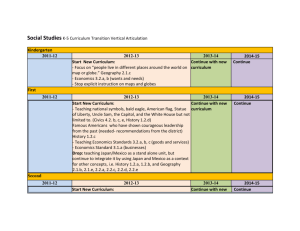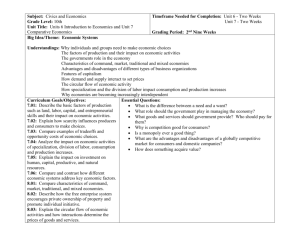Elementary Sample_1-24
advertisement

School/District: Any School District, USA UNIT TITLE: Meeting Our Basic Needs Conceptual Lens: Interdependence Grade Level/Course: Third Grade Author: Curriculum Development Team Members Unit Overview: There is a growing recognition from educators and other leaders that to be effective citizens, students must have a basic understanding of the economic world around them. In this unit, we will equip students with the knowledge and tools necessary for them to understand the basic principles of economics and how to apply the basic needs and key elements (wants and needs, supply and demand, trade and interdependence, etc.) to real world situations so students can make informed choices in their roles as consumers, producers, savers, as well as voters. Student learning will focus on the basic needs within their county and/or region and natural resources in their environment. Students will complete learning activities and performance tasks to gain an understanding of how communities are interdependent on each other to satisfy their basic needs. Student learning will focus on the interdependence of the people and places (neighborhoods and communities) within their county. [Third Grade Sample Unit] History Geography and Environmental Literacy (3.G.1.1, 3.G.1.3) CONCEPT/CONTENT WEB Civics and Government (3.C&G.2.1, 3.C&G.2.2) Citizenship Community roles Leadership Rules and laws Common good Economic, social and political contributions Unit Title/Topic Meeting Our Basic Needs Culture Location (absolute & relative) Place (human &/or physical characteristics) Population distribution Movement (goods, people, &/ or ideas) Adaptation Environment (natural & man-made) Change Region Food and shelter Economics and Personal Financial Literacy (3.E.1.1, 3.E.1.2, 3.E.2.1, 3.E.2.2) Needs and wants Supply and demand Scarcity Goods and services Division of labor Economic decision-making Entrepreneurship Consumer Producer Natural resources Trade Market economy Other Subjects Other subjects that could be added for interdisciplinary approach: English Language Arts Science Math Information and Technology Page 2 of 8 Essential Understandings (Generalizations) and Guiding Questions: Generalizations Guiding Questions Factual (F), Conceptual (C), and Provoctive/Debatable (P) History Geography & Environmental Literacy History 1. The physical environment of a place can determine the way that people meet their basic needs. Geography & Environmental Literacy 2. Humans may change or adapt to their environment in order to meet their needs. Civics & Government 3. Rules and laws may be necessary to protect Civics & Government 4. Responsible citizens contribute to the common good of the community. Page 3 of 8 1a. What are some examples of basic needs that all people have? (F) 1b. What are some ways that you and your family meet their basic needs? (F) 1c. What is the physical environment like in your community? (F) 1d. What is it important for people to understand their physical environment? 2a. How might humans interact with the environment to meet their needs? (C) 2b. How do people in your community meet their basic needs? (F) 2c. Is human interaction with the environment always positive? (P) 3a. What are some examples of rules and laws that citizens must obey in your community? (F) 3b. Why do communities have rules and laws? 4a. What are the various roles that people may play in your community? (F) 4b. Why are those roles important? (C) 4c. What is the difference between a right 4d. 4e. Economics & Personal Financial Literacy 5. People in a market economy contribute to the economic development of their community. Economics & Personal Financial Literacy 5a. 5b. 5c. 5d. 5e. 6. The law of supply and demand in a market economy works to keep the economy stable. and a responsibility? (F) What are the characteristics of a responsible citizen? Why is it important to be a responsible citizen? (C) What are the basic elements of a market economy? (C) What are some examples of countries with a market economy? (F) What are some typical roles that people might play in a market economy (C)? How might you participate in our economy? (F) Why it important for people to contribute to the economy? (C) 6a. What are some roles that people play in a market economy? (F) 6b. How does a market economy work? (C) 6c. What is the law of supply? (C) 6d. What is the law of demand? (C) 6d. What might happen if consumers demand more than is supplied? (C) 6e. What might happen if producers produce more than consumers want (C) 6c. What do you understand about how these two laws work together? (C) Culture Culture Other Subjects Other Subjects Page 4 of 8 Critical Content and Skills Q = Quizzes T = Tests P = Prompts Students Will Know… (factual content) AC AC = Assessment Codes SA = Student Self-Assessment WS = Work Samples PT = Performance Tasks O = Observations D = Dialogues Students will be able to do… (key skills) AC 1. Basic Economic terminology i.e. consumers, producers, the difference between a need and a want, etc. Q/T 1. Research and use technology to access and present information WS/PT 2. Identify various leadership roles in the community and their functions. D 2. Use map and graphs to locate places and resources. O/WS 3. The natural resources located in their community and the ways in which they are use. D Page 5 of 8 Performance Tasks and Scoring Guides/Rubric Performance Task #1 including Scoring Guide/Rubric Research/Presentation: What: As a member of your town council, you have been asked to be a member of a team who will develop a plan to make sure that everyone in your community has their basic needs met. You and your team will research the resources available in your community. Why: In order to understand that: The physical environment of a place can determine the way that people meet their basic needs. Humans may change or adapt to their environment in order to meet their needs. How: In teams of three, students will select a community from the options provided and research the needs the resources that are located there. The team will use maps and charts to show where the resources are located and the percentage of that resource. Using other visual representations, including computer programs, students will create a presentation/display board that shows their plan of action for the community. The teams will share their research findings by explaining the graphic organizer to the class. Then the students will display their work around the classroom so their classmates can do a gallery walk. Rubric for Basic Needs CRITERIA Content/Graphic Organizer Delivery: Eye contact, voice, gestures props Achievement of Purpose/Understanding: EXCELLENT (4 PTS.) Engaging thoughts and insightful presentation of thoughts and supporting details Outstanding variety of non-verbal cues and communicates well with the audience Clearly explains in detail, the connection between the basic needs of a community and the physical environment of their community. PROFICIENT (3 PTS.) Clear and thoughtful presentation of thoughts and supporting details Very good variety of nonverbal cues and communicates with the audience Explains, with some detail, the connection between the basic needs of a community and the physical environment of their community. Page 6 of 8 ADEQUATE (2 PTS.) Straightforward and developing presentation of thoughts and supporting details Satisfactory variety of nonverbal cues and communicates some with the audience Somewhat explains the connection between the basic needs of a community and the physical environment of their community. LIMITED (1 PT.) Simplistic presentation of thoughts and supporting details. Limited variety of nonverbal cues and doesn’t communicate well with the audience Vaguely explains the connection between the basic needs of a community and the physical environment of their community. Suggested Learning Experiences CORRELATIONS → Enduring Understanding 1,4,6 1. Graphic Organizers such as charts on wants and needs/supply and demand, producers and consumers, natural resources 2. Create games such as Concentration/Bingo, etc. to address facts and terminology Critical Content 1,2 2 3. Use a concept web to determine and guide basic needs and how they are developed 8,11 4. Create a collage or scrapbook about human needs, natural resources, etc. 2,7 Key Skills 2 2 4 4 5 5. Journal writings and reflections 6. Venn Diagram (wants/needs) 2 7. Bubble Concept mapping including visual representations of basic needs and natural resources. 3,6 Page 7 of 8 2 Unit Materials/Resources Teacher Notes Teaching Economics Using Children’s Literature by Maryann Foltz, Suellen Reed and Harlan R. Day. Available:http://www.amazon.com/s/ref=nb_sb_ss_i_0_20?url=searchalias%3Dstripbooks&fieldkeywords=teaching+economics+using+children%27s+literature&sprefix= Teaching+Economics+u Sample rubrics: http://www.rcampus.com/rubricshowc.cfm?code=G68492&sp=true& http://www.rubrics4teachers.com/roleplay.php Use resource teachers (art, P.E., music, etc.) in the planning process for the “Classroom Community” performance task. Work collaboratively with media and technology specialists for resources to develop unit. Differentiation: May choose to have students work in pairs/teams to research and create graphic organizers for presentation. Students could be assigned roles of recorder/writer, presenter, etc. Page 8 of 8







